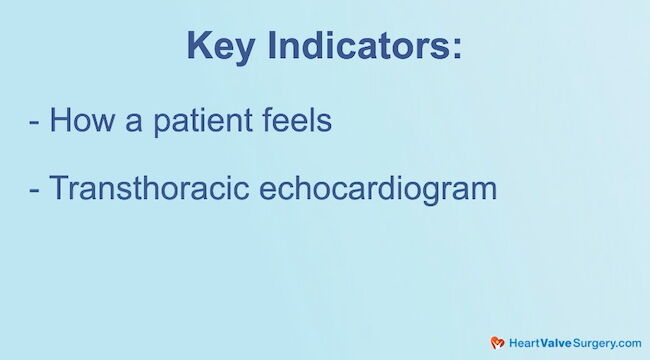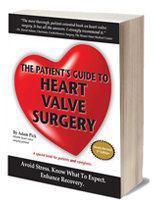Bicuspid Aortic Valve: Key Indicators for Timing Surgery
Written By: Allison DeMajistre, BSN, RN, CCRN
Medical Expert: Marko Boskovski, MD, Aortic Valve Surgeon, University of California San Francisco
Reviewed By: Adam Pick, Patient Advocate, Author & Website Founder
Published: August 25, 2025
Bicuspid aortic valve is the most common congenital heart defect present at birth. However, it is often asymptomatic into adulthood. Without symptoms, most patients with a bicuspid aortic valve will be in a “watchful waiting” phase with regular medical testing to monitor for progressing aortic stenosis or regurgitation. A bicuspid aortic valve makes the heart work harder and symptoms may develop. Surgery to repair or replace the a bicuspid aortic valve can be necessary. Timing the surgery is different for every patient, often causing worry and stress among patients as they wonder when or if surgery will be required.
We received a great patient question about bicuspid aortic valve disease from Amy, who asked, “What is the most important indicator for bicuspid valve patients in the ‘waiting room’ to monitor and determine when surgery is needed?” We were thrilled to have Dr. Marko Boskovski, a leading aortic valve surgeon at the University of California in San Francisco, join us to answer Amy’s question.
Facts About Bicuspid Aortic Valve and Timing Surgery
Here are the key insights shared by Dr. Boskovski:
- There are specific symptoms to watch for progressive bicuspid aortic valve disease. “That is a great question, a very important one,” said Dr. Boskovski. “There are two things we primarily focus on. One is how a patient feels. There are symptoms we focus on, like difficulty breathing, especially with activity, and fatigue. Feelings like you’re going to pass out or if you have passed out. Those are things that would be indicators that the aortic valve may be significantly diseased.”

- Echocardiograms are critical for evaluating when or if a patient requires surgery. “In addition to symptoms, a test called transthoracic echocardiogram is a diagnostic tool we rely on heavily that shows what the valve looks like. Is it bicuspid or not? How does it function? Does it have any tightness or stenosis, or is it leaking? What is the severity of those issues? Typically, if you have severe valve disease and you have symptoms, then intervention is considered.”
Thanks Dr. Boskovski and UCSF Health!
On behalf of all the patients in our community, thank you, Dr. Marko Boskovski, for everything you and your team are doing at UCSF in San Francisco, California!
Related links:
- See Dr. Boskovski’s Interactive Surgeon Profile
- Dr. Boskovski Q&A: Is Minimally Invasive Aortic Root Replacement Possible?
Keep on tickin,
Adam
P.S. For the deaf and hard-of-hearing members of our patient community, we have provided a written transcript of our interview with Dr. Boskovski below.
Video Transcript:
Adam Pick: Hi, everybody. It’s Adam with HeartValveSurgery.com and we are in Los Angeles, California at the Society of Thoracic Surgeons Conference. I am thrilled to be joined by Dr. Marko Boskovski, who is a leading aortic valve surgeon at the University of California San Francisco. Dr. Boskovski, it is great to see you. And thanks so much for being with me today. Thank you for having me.
Dr. Marko Boskovski: It’s a pleasure.
Adam Pick: We’re here at STS and we’re getting a lot of new research and data about treating aortic valves. We’re also getting questions from patients coming in from all over the world. This question is right in your specialty. It comes in from Amy and she asks, “What is the most important indicator for bicuspid aortic valve patients in the “waiting room” to monitor and to determine when surgery is needed?”
Dr. Marko Boskovski: That’s a great question, a very important one. There’s two things primarily that we focus on. One is how a patient feels. There are symptoms that we focus on and these are things like difficulty breathing, especially with activity, fatigue. Feelings like you’re going to pass out or if you have passed out.
Those are some things that would be indicators that the aortic valve may be significantly diseased. In addition to symptoms, a test called transthoracic echocardiogram is a diagnostic tool we rely on heavily that shows what the valve looks like. Is it bicuspid or not? How it functions? Does it have any stenosis or tightness? Or is it leaking? And what the severity of those issues? And typically, if you have severe valve disease and you have symptoms, then intervention is considered.
Adam Pick: Great. Well, Amy, I hope that helped you. I know it helped me and Dr. Baskowski on behalf of Amy and the patients at HeartValveSurgery.com, patients all over the world, thanks so much for what you and your team are doing at the University of California in San Francisco. Thanks for being with me today.
Dr. Marko Boskovski: You’re very welcome. Thank you.





